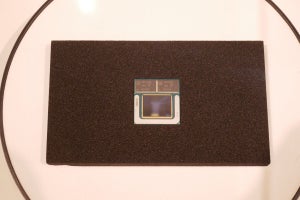List 2:
<html>
<head>
<meta http-equiv="refresh" content="300">
<title>Ethernet Camera Test Page</title>
</head>
<body>
<img src="picture.jpg">
</body></html>
List 3:
// Written by IVA2K
//
// Example of HTTPServer with additional features:
// * SNTP Client (Simple NTP)
// * Link status indication (LED4 or RJ45 socket LED on MBED-BoB2-mod)
// * Local file system (create index.htm page on MBED!)
// * SD-based WebServer
// * RPC-able class (myrpc, allows remote function call that blinks LED1 N times)
// * Static HTML page
// * Dynamic HTML page
//
// Instructions:
// 1 Plug MBED into MBED-BoB2 (or other ETH connector breakout)
// 2 Plug ETH connector into your network (needs DHCP to get IP address and Internet connection)
// 3 Power up MBED using USB cable
// 4 Install MBED serial driver (http://mbed.org/handbook/SerialPC)
// 5 Copy compiled .bin to your MBED (make sure target device selected in the compiler is correct)
// 6 Open terminal on the mbed serial port
// 7 Push MBED reset button
// 8 Terminal will display info message with mac address, followed by IP address (if connection succeeds)
// in the following items, replace 10.0.0.321 with actual MBED IP address from the terminal
// 9 Open browser and enter the following URL:
// http://10.0.0.321/rpc/myrpc1/blink,10
// 10 MBED will blink the LED 10 times
// 11 Open browser and enter the following URL:
// http://10.0.0.321/rpc/myrpc1/gettime
// 12 The browser will show date and time from the MBED synchronized to NTP server
// 13 Open browser and enter the following URL:
// http://10.0.0.321/static.htm
// 14 The browser will show static HTML page
// 15 Open browser and enter the following URL:
// http://10.0.0.321/dynamic.htm
// 16 The browser will show dynamic HTML page
// 17 Create a simple index.htm page on the MBED
// 18 Open browser and enter the following URL:
// http://10.0.0.321
// 19 The browser will show index HTML page
// 20 Create a simple index.htm page on a micro SD card, plug the card into MBED-BoB2
// 21 Open browser and enter the following URL:
// http://10.0.0.321
// 22 The browser will show index HTML page from SD card
// 23 Optionally, create file "sntp.ini" on MBED or SD card. Copy-paste SNTP configuration from the terminal into this file and modify to your needs.
//
// Notes: there are still some bugs in HTTPServer code.
// To help fight some of them, copy a valid favicon.ico (a 16x16 icon) file to MBED.
//
#include "mbed.h"
#include "SDFileSystem.h"
#include "HTTPServer.h"
#include "HTTPRPC.h"
#include "HTTPFS.h"
#include "HTTPStaticPage.h"
#include "HTTPDynamicPage.h"
#include "HTTPLinkStatus.h"
#include "SNTPClient.h"
#define CLS "\033[2J"
const char content[] =
"<HTML>"
"<HEAD>"
"<title>Static Page</title>"
"</HEAD>"
"<BODY>"
"<H1>Hello World</H1>"
"<p>Page generated statically from code.</p>"
"</BODY></HTML>"
;
#define MAX_DYNAMIC_CONTENT_LEN 2048
char dynamic_content[MAX_DYNAMIC_CONTENT_LEN];
const char content_fmt[] =
"<HTML>"
"<HEAD>"
"<title>Dynamic Page</title>"
"</HEAD>"
"<BODY>"
"<H1>Hello World</H1>"
"<p>Page generated dynamically from code.</p>"
"<p>URL=%s</p>"
"<p>Header Fields=%s</p>"
"</BODY></HTML>"
;
DigitalOut led1(LED1, "led1");
DigitalOut led2(LED2, "led2");
DigitalOut led3(LED3, "led3");
DigitalOut led4(LED4, "led4");
DigitalIn sw1(p9, "sw1");
DigitalIn sw2(p10, "sw2");
LocalFileSystem local("local");
SDFileSystem sd(p5, p6, p7, p8, "sd"); // MBED-BoB2
#include "myrpc.h"
myrpc myrpc1(LED1, "myrpc1");
extern Ethernet eth; // eth is defi ned elsewhere, avoid compiler error.
Serial pc(USBTX, USBRX);
int gDebug=1;
float gWait = 0.005; // Main loop wait timeout
#include "Camera_LS_Y201.h"
Camera_LS_Y201 cam(p13, p14);
long captureWait = 12000; // Capture interval count
int Camera_Ready = FALSE; // Camera Ready FLAG
FILE *fp;
void camera_callback(int done, int total, uint8_t *buf, size_t siz)
{
fwrite(buf, siz, 1, fp);
}
void captureImage()
{
time_t seconds;
char workBuf[10];
if ( !Camera_Ready ) return;
if (gDebug > 0 )
{
seconds = time(NULL);
strftime(workBuf, 10, "%H:%M:%S", localtime(&seconds));
printf("%s captureImage start....", workBuf);
}
if (cam.takePicture() != 0)
{
cam.stopTakingPictures();
if (gDebug > 0 )
{
seconds = time(NULL);
strftime(workBuf, 10, "%H:%M:%S", localtime(&seconds));
printf("\r\ntakePicture failed....%s\r\n", workBuf);
}
Camera_Ready = FALSE;
return;
}
/* create/open picture.jpg */
fp = fopen( "/local/picture.jpg", "wb" );
if (fp == NULL)
{
if (gDebug > 0 )
{
seconds = time(NULL);
strftime(workBuf, 10, "%H:%M:%S", localtime(&seconds));
printf("\r\nfile openinig failed....%s\r\n", workBuf);
}
cam.stopTakingPictures();
Camera_Ready = FALSE;
return;
}
/* save JPEG image into picture.jpg */
if (cam.readJpegFileContent(camera_callback) != 0)
{
if (gDebug > 0 )
{
seconds = time(NULL);
strftime(workBuf, 10, "%H:%M:%S", localtime(&seconds));
printf("\r\nfile writing failed....%s\r\n", workBuf);
}
cam.stopTakingPictures();
fclose(fp);
Camera_Ready = FALSE;
return;
}
/* post file save process */
fclose(fp);
cam.stopTakingPictures();
if (gDebug > 0 )
{
seconds = time(NULL);
strftime(workBuf, 10, "%H:%M:%S", localtime(&seconds));
printf("Done.%s\r\n", workBuf);
}
}
HTTPStatus myDynamicPage(HTTPConnection *con, HTTPDynamicPageData *pd) {
#if 0
// Static example. With this, we don't really need HTTPStaticPage
pd->size = 0; // let it measure our page
pd->page = (char*)content; // Nothing dynamic about that yet, but we can now get loose here.
pd->page_free = NULL; // No mem free() needed
#elif 0
// Dynamic example, static buffer
pd->size = sprintf(dynamic_content, content_fmt, con->getURL(), con->getHeaderFields());
pd->page = (char*)dynamic_content;
pd->page_free = NULL; // No mem free() needed
if(pd->size > sizeof(dynamic_content)) printf("ASSERTION FAILED: %s:%d\r\n", __FILE__, __LINE__); // Buffer overrun
#else
// Dynamic example, dynamic buffer
int size = sizeof(content_fmt) + 512; // Just guess how much the data will expand
char *buf = (char *)malloc(size);
if (buf) {
pd->size = sprintf(buf, content_fmt, con->getURL(), con->getHeaderFields());
pd->page = buf;
pd->page_free = &free; // Use free() when done
if(pd->size > size) printf("ASSERTION FAILED: %s:%d\r\n", __FILE__, __LINE__); // Buffer overrun
#endif
}
return HTTP_OK;
}
int main(void) {
char mac[6];
int sw1_old=0, sw2_old=0;
bool use_sd = false;
long lpCnt;
led1=1;
led2=1;
led3=1;
led4=1;
// Start RTC
time_t seconds = time(NULL);
if (seconds == (unsigned)-1 || seconds == 0) {
seconds = 1256729737; // Set RTC time to Wed, 28 Oct 2009 11:35:37
set_time(seconds);
printf("RTC initialized, start time %d seconds\r\n", seconds);
}
char *hostname = "mbed";
HTTPServer http(hostname); // Use DHCP
http.timeout(10000); // Sets the timout for a HTTP request. The timout is the time which is allowed to spent between two incomming TCP packets. If the time is passed the connection will be closed.
eth.address(mac);
pc.printf(CLS "\r\n\r\nHTTPServer \"%s\" started\r\nMAC %02X:%02X:%02X:%02X:%02X:%02X\r\n%s",
hostname, mac[0], mac[1], mac[2], mac[3], mac[4], mac[5],
gDebug?"Debug is ON\r\n":""
);
Base::add_rpc_class<AnalogIn>();
Base::add_rpc_class<AnalogOut>();
Base::add_rpc_class<DigitalIn>();
Base::add_rpc_class<DigitalOut>();
Base::add_rpc_class<PwmOut>();
Base::add_rpc_class<Timer>();
Base::add_rpc_class<SPI>();
Base::add_rpc_class<BusOut>();
Base::add_rpc_class<BusIn>();
Base::add_rpc_class<myrpc>();
led1=0;
// Check if we can use SD card for the web server
FILE *fp = fopen("/sd/index.htm", "r");
if (fp == NULL) {
if (gDebug) printf("DEBUG: No SD card found or no index.htm file - using LocalFilesystem for WebServer.\r\n");
} else {
use_sd = true;
fclose(fp);
if (gDebug) printf("DEBUG: Found SD card with index.htm file - using SD for WebServer.\r\n");
}
if (0 != SNTPReadIniFile("/sd/sntp.ini") )
SNTPReadIniFile("/local/sntp.ini");
SNTPWriteIniFile(stdout);
http.addHandler(new HTTPLinkStatus("/",
#if MBED_BOB2
p25, p26, // MBED-BoB2-mods
#else
LED3, LED4,
#endif
0.1,
/*do_urlfile*/ true, /*do_link_printf*/ true, /*do_log_printf*/ false,
/*log_file*/ ( (gDebug>1) ? (use_sd ? "/sd/httpd.log" : "/local/httpd.log") : NULL)
)); // Should be the first handler to get a preview of all requests
http.addHandler(new HTTPRPC());
led2=0;
// Static/Dynamic pages must be installed before FileSystem on /
http.addHandler(new HTTPStaticPage("/static.htm", content, strlen(content)));
http.addHandler(new HTTPDynamicPage("/dynamic.htm", &myDynamicPage));
http.addHandler(new HTTPFileSystemHandler("/", use_sd ? "/sd/" : "/local/"));
led3=0;
// FIXME: BUG If eth is not plugged, http.bind() hangs!
http.bind();
SNTPClientInit();
led4 = 0;
// Camera Setup & Start Capture
printf("\r\nResetting camera...\r\n");
if (cam.reset() == 0)
{
if (gDebug > 0 )
printf("Camera Reset OK.\r\n");
wait(1);
// Setting image Size
/* cam.setImageSize(cam.ImageSize160x120); */
cam.setImageSize(cam.ImageSize320x280);
/* cam.setImageSize(cam.ImageSize640x480); */
Camera_Ready = TRUE;
}
else
{
if (gDebug > 0 )
printf("Camera Reset Failed.\r\n");
}
pc.printf("\r"); // Add linefeed for stupid Hyperterminal
captureImage(); // Take 1st picture
while(1)
{
for(lpCnt = 0; lpCnt < captureWait; lpCnt++)
{
http.poll(); // Have to call this method at least every 250ms to let the http server run.
if (sw1 & !sw1_old) {
printf("SW1\r\n");
}
if (sw2 && !sw2_old) {
printf(CLS "SW2\r\n");
}
sw1_old = sw1;
sw2_old = sw2;
wait(gWait);
}
captureImage();
}
}
//END
ということで
今回はmbedを使っての、ちょっとした工作の事例をご紹介した。OSこそ搭載されないものの、簡易型のTCP/IPスタックやFATファイルシステムが利用でき、しかもMCUらしくI/Oポートをバリバリ触ったプログラムが簡単に書けることがお分かりいただけよう。
ブラウザベースの開発環境も他に類を見ないもので、これによりネットワークが繋がってさえいれば、いつでもどこでも作業を再開できる、ちょっとクラウド時代っぽい環境なのは面白いと思う。またcookbookを始めとして、他人の公開しているプログラム/ライブラリをすぐ取り込んだり、逆に自分の作ったプログラム/ライブラリをすぐに世界中に公開できるというのも、これまでには無かったものだ。プログラムの勉強という意味でも、MCUの勉強という意味でも、あるいはホビーとしてちょっと凝ったものを作りたいなんてケースでも、mbedは良い道具になると筆者は感じる。少なくとも、これが6000円未満というのは、やはり安いと強く感じる。



















